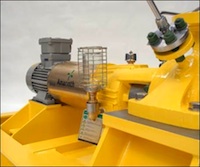
Oliver Brigginshaw, managing director of Amarinth, looks at some of the lessons learned from its experiences of supplying pumps to the Prirazlomnoye oilfield in northern Russia:
Amarinth has been engaged by many global oil and gas companies to provide advice and design pumps that can withstand the hostile environment of the sub-arctic ice.
One such sub-arctic location which Amarinth has recently supplied winterised pumps into is the Prirazlomnoye oilfield located south of Novaya Zemla in northern Russia on the Pechora sea shelf, at a distance of 60km from the shore.
This region is subject to extremely low temperature s and strong ice loads. It is ice free for only 110 days a year and the cold period lasts 230 days. The ice thickness is up to 1.7m and the annual average temperature is -4°C with a minimum of -50°C.
Interestingly, when it comes to selecting pumps for extreme low temperature conditions, the purchaser will simply note on the technical data sheet that the pumps need to be winterised, usually in the note section or added to the environment section.
Amarinth has not been able to find any industry standard definition of what winterisation actually means in relations to pumps and what should be done to the equipment achieve this.
Therefore Amarinth has developed its own list of considerations to ensure that its pumps will operate reliably in sub-arctic conditions such as the Prirazlomnoye oilfield, some of which are shared below.
Stainless steel is the minimum choice of material for extreme low temperatures as it is much stronger and less brittle than normal carbon steel as the temperature falls. However, other factors such as the pumped fluid have also to be considered. For example, produced water is often rich is hydrogen sulphide (H2S), which would corrode a stainless steel pump.
The best material for produced water pumps, such as those Amarinth supplied to the Prirazlomnoye oil field, is duplex stainless steel, and so designers must always take care to balance the temperature requirements of the site and the material requirements of the pumped fluid and then find a suitable compromise.
Base plates are usually manufactured from low carbon steel which is suitable down to -25C. However, beyond this point stainless steel should be considered as low carbon steel will start to suffer from brittleness.
Tests such as Charpy Impact Testing should be carried out on the chosen material to make sure it will be suitable for the temperatures that will be experienced on site.
In sub-arctic regions such as the Prirazlomnoye field where minimum temperatures can reach -50C, components for couplings have to be carefully selected for very low temperature and it is important that in these extreme conditions that the coupling manufacturers work closely with the pump manufacturer to define the operating conditions.
Steel variations must also be considered, for example, Drive bolts can be induction hardened and made suitable for higher strength applications when resistance to shock is also required.
Seal systems, particular for hazardous fluids such as the produced water being treated by the nutshell filters in the Prirazlomnoye field, must be carefully considered with safeguards built into the design to allow the storage and operation of the systems when conditions are as low as -50C.
Low temperature materials and elastomers must be selected, such as low temperature nitrile bladders for accumulators.
Stainless steel materials are stronger at low temperatures and generally recommended to replace any carbon steel components within the seal support systems. For cold duties, the systems can also be trace heated or lagged.
For temperatures as low as -50°C, specialised paint finishes may be required such as two pack epoxy abrasion resistant coating which would have low ice adhesion and low frictional resistance. The typical film thickness for extreme low temperature would be in the region of 400-500 microns.
